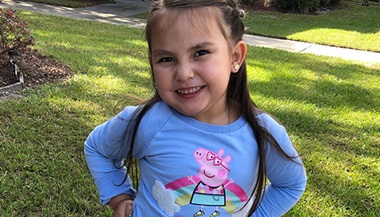Patient Story
Parry-Romberg Syndrome: Marianna's Story

Something was different. Marianna looked in the mirror. She couldn’t quite put her finger on it, but she knew something wasn’t right. There was a small indentation on her forehead that wouldn’t go away. Her mom noticed it too.
At first, they thought it might relate back to her brother accidentally hitting her with a baseball bat. The family pediatrician told them not to worry about it. But Marianna’s uncle stepped in and suggested they go see a neurologist. The family worked their way through several doctors in the Sarasota area before someone finally referred them to the plastic surgery program at Johns Hopkins All Children’s Hospital.
The diagnosis for Marianna, then 14, was Parry-Romberg syndrome, a rare condition that occurs in about 1 in 700,000 adolescents. It had nothing to do with an errant baseball bat. Her brother was happily off the hook. The best part was, it was fixable.
“Parry-Romberg is a condition that causes progressive shrinking of the soft tissues of one side of the face. It can also affect the facial bones,” explains Alex Rottgers, M.D., Marianna’s plastic surgeon. “Gone unchecked, it can cause significant changes to the face and disfigurement. In Marianna’s case, it had progressed to cause wasting of the upper half of the right side of her face by the time she came to see me. When treating patients such as Marianna, we partner with our rheumatology colleagues to help stop the progression of the disease. Then we discuss options for reconstructive surgery.”
“Dr. Rottgers put us at ease right away,” mom, Araceli, recalls.
“I wasn’t scared at all, Dr. Rottgers made me feel really comfortable,” Marianna explains. “He said all of those other doctor visits were behind us.”
Marianna had the first of two procedures to reshape her face using a newer technique that involves fat transfers to replace lost volume in areas affected by the condition.
“In the past, extensive microvascular tissue transfer procedures were needed to restore the lost facial volume. These are still sometimes necessary in the most severe cases of Parry-Romberg disease, but in most cases, by using fat grafting techniques, the quality of the results are much improved,” Rottgers explains. “The appearance and movement of the face is more natural and recovery is easier and quicker.”
Rottgers, who is one of the few craniofacial surgeons in the Tampa Bay area, is known for taking care of uncommon conditions such as Parry-Romberg. “Our expertise includes complex reconstruction for the purposes of correcting facial deformities to improve a patient’s form, function and self-confidence,” he explains.
“Marianna is doing really well, which makes me very happy,” he says. “She’s a lovely young lady and she’s enjoying a great result.”
Rottgers is focusing his team on research that will improve and define the ways outcomes such as Marianna’s are measured in patients—specifically those with cleft lip and palate, another of his specialties. His goal is to make each procedure as easy and comfortable for each patient he serves.
Marianna, who is now 18, is happy that Rottgers will continue to follow her progress annually at least until she is 22, just to make sure the fullness remains in her face, and she doesn’t require any tweaking or follow-up treatment.
The family was thrilled to find the actual cause of her facial issues and to have discovered Rottgers, but they’d still like her to stay away from baseball bats, just in case.
Marianna's Surgeon
Plastic & Reconstructive Surgery at Johns Hopkins All Children's Hospital






